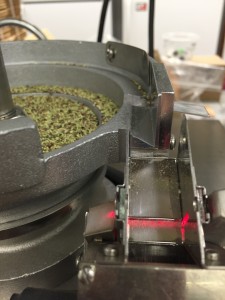 We’ve been collecting a lot more Harpalus pensylvanicus these past few weeks. We’ve been finding about 15-30 a day, which is a very sharp change from the beginning of August. Harpalus is a genus of ground beetle with different species commonly found throughout the contiguous United States and Canada. Harpalus pensylvanicus is known as a species prevalent in croplands. You can see they are pretty easily ID-able by their tan/orange legs along with a more shiny body in contrast to other similar looking species. As seeds make up the primary portion of their diet, they have been found to be most active in the fall after weeds and the like have shed their seeds. This is why we didn’t see too many throughout the summer. Different studies have worked at trying to pinpoint the species’ eating habits and preference. (As I said in the previous post, few if any of these studies refer to cover crops). They are an important predator of many weeds. One study told of how the trials they ran resulted in this species eating up to 90% of weed seeds. It’s important to consider that not all weeds are considered cover crops. There are weeds that are accepted as generally harmful to agricultural systems from both an economic and ecological perspective. The purpose of SPOC is to test the preference of these definitive weeds against other species of plants that can are often be thought of as weeds but can be used as cover crops, and to help re-contextualize the discussion surrounding seed predation to include cover crops.
We’ve been collecting a lot more Harpalus pensylvanicus these past few weeks. We’ve been finding about 15-30 a day, which is a very sharp change from the beginning of August. Harpalus is a genus of ground beetle with different species commonly found throughout the contiguous United States and Canada. Harpalus pensylvanicus is known as a species prevalent in croplands. You can see they are pretty easily ID-able by their tan/orange legs along with a more shiny body in contrast to other similar looking species. As seeds make up the primary portion of their diet, they have been found to be most active in the fall after weeds and the like have shed their seeds. This is why we didn’t see too many throughout the summer. Different studies have worked at trying to pinpoint the species’ eating habits and preference. (As I said in the previous post, few if any of these studies refer to cover crops). They are an important predator of many weeds. One study told of how the trials they ran resulted in this species eating up to 90% of weed seeds. It’s important to consider that not all weeds are considered cover crops. There are weeds that are accepted as generally harmful to agricultural systems from both an economic and ecological perspective. The purpose of SPOC is to test the preference of these definitive weeds against other species of plants that can are often be thought of as weeds but can be used as cover crops, and to help re-contextualize the discussion surrounding seed predation to include cover crops.
One study (co-authored by Matt Ryan!) looked at Harpalus pensylvanicus preference of Giant Foxtail. Giant Foxtail is an example of a plant that isn’t considered useful as a cover crop, it is generally considered to be undesired in agricultural fields. The study was run through two seasons and found that not only did the beetles prefer newly shed foxtail seeds to older aged ones, but also the population density of beetles was found to hit its maximum at the same time foxtail seed shed began.
The pictures above show the seed counter I spent time using in August to separate Giant Foxtail seeds from small debris and count them. I had never seen a machine like this before so it was fun to spend a few hours working with it. You set it so it rotates and vibrates with a certain amount of power depending on how heavy the seeds are you hope to count. The seeds travel around the cylinder while other debris stays behind. Eventually the seeds make their way to the top and pass across a laser as they are deposited out of the spout. They are counted one by one digitally.


